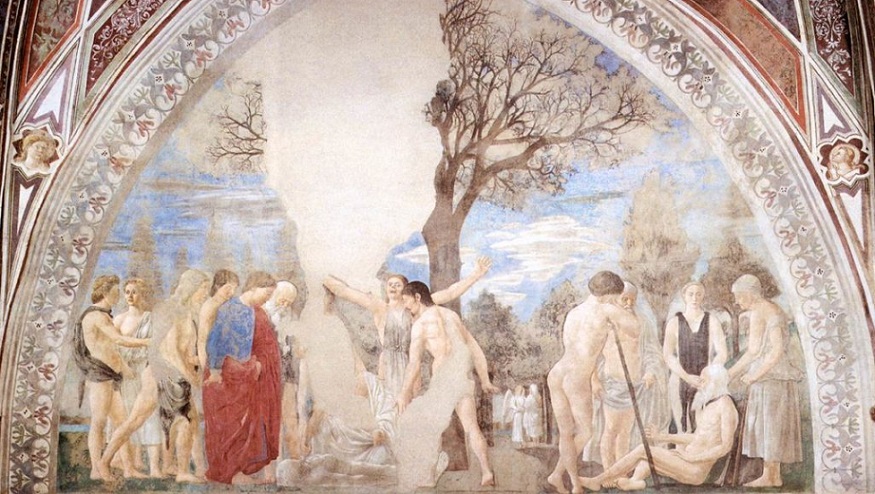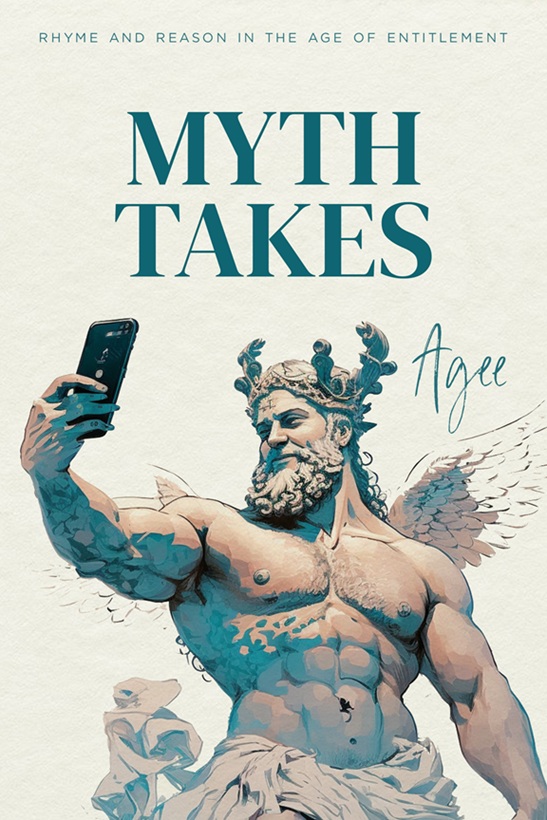.
The Death of Adam
Excerpted from Musings on Piero della Francesca’s “History of the True Cross,” in the Church of San Francesco, Arezzo, Italy
There’s always both: the sacred and profane.
The right tends to the former, left the latter.
The weak side’s earthbound, ugly, heavy matter,
where even Mankind’s Father’s on the wane.
However, there’s The Tree. In spite of Cain,
No matter how we sever, sunder, scatter,
salvation’s handed to us on a platter.
If Adam died, he didn’t die in vain.
Seed enters through the orifice, and sprouts.
Our molecules don’t die, they just regroup.
Death? Birth, marriage?—Jumping through the hoop.
Each individual is racked by doubts,
but tranquil tropes just complete the loop.
Eternity is mere primordial soup.
Nine panels (if we drop the “Annunciation,”
the evil fruit of nepotism, simony
and other ills), a far-from straight narration,
obscure events, abstruse concatenation,
distractions in the shape of sundry women he
encountered on sabbatical in Rimini,
all render this improbable creation
a triumph, and an ultimate salvation.
Fine drawing. Elements which interlace.
The whole achieved with understated grace.
And art that’s richer, since its simple span
has freed it up. Man’s measure now is Man!
Old Adam is now dying. Seth decides
to ask for Heaven’s help. An angel shows
him where The Garden is, and then confides:
“Seek out the Tree of Knowledge, which provides
for Man’s prosperity. Whatever grows
out of its seeds will do great deeds, for those
are fruits of Heaven.” Adam’s life subsides.
Seth’s reappearance barely coincides
with father’s final moments. On his tongue
the son inserts the seeds of knowledge. Seth
observes that shoots and tendrils, vital, young,
are now cascading from his mouth. Among
the mourners, heartbreak at their father’s death
combines with something else. His dying breath
is not an end. A greater life has sprung
from what he was. The wonder spreads along
the line of relatives. One daughter’s scream
(who’s left to doubt Piero’s on a mission?)
prefigures crucifixion. It’s a scheme
so radical as almost to blaspheme
against accepted norms of composition!
The left-to-right and up-and-down rendition
resembles Jesus’ Cross and, beam by beam,
sets out to re-invent—and thus redeem.
The horizontal planes are plain as day.
Above there’s no corruption, static sky.
Below, commotion. Catastrophic clay
convulses creatures. Caught in passion-play,
condemned from cradle to their dying cry
to struggle, ail and fail, decline and die,
they dance their barren ballet of decay.
Like cinders in the wind, they’re blown away.
But don’t forget the vertical. The tree
luxuriates and dominates the scene.
Piero plies with due humility
Alberti’s strictures. Note the symmetry—
the fluted column where the mobled queen
reveres the timber, or the neat machine
for pulling Jews from trenches—could it be,
that middle-line divider helps us see?
.
.
Barrister, teacher and journalist, Michael Coy is an Irish poet who has settled permanently in the south of Spain. He readily admits to a serious rhyme-and-rhythm habit. Winner of various poetry prizes in Britain and Ireland, Michael has been published fairly regularly in the British poetry journal, ”Orbis.”
















The elaborate train of thoughts in this poem is much to my liking. I also liked your “free” rhyme. Perhaps there is a pattern there, but so far I have not been able to figure it out. No matter! The poem is rich in idea and in rhyme, and that’s what kept me interested.